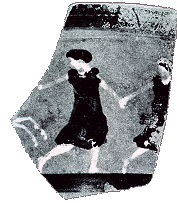
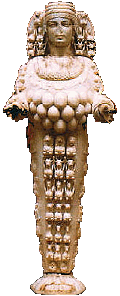
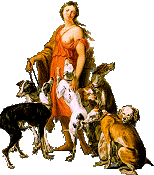
| Roman
Name: Diana Sacred Cities: Ephesus; Brauron; Aulis; Delos Totem Animals: The Deer and the Bear Her Plant: The Cypress Tree How to Identify Her: She's usually hunting. Favors a short skirt so she can give chase. Sometimes bares one (never both) of her breasts.
|
Artemis's role in the birth cycle is referred to in the famous statue at the upper left side of this page, the Artemis of Ephesus, whose multitude of breasts (or, as some art historians would have it, a multitude of eggs, or even, as our textbook mentions, bulls' testicles) indicates her fertility/nature aspects. This particular statue also emphasizes her role as Potnia Theron, the Lady of the Beasts, as you can see in this close-up of the animals carved into her robe.
The image on the upper right is far more familiar, the young maiden who likes to hunt in the woods with her bow and arrows. It's also a more comfortable image! There's something austere and scary about the Ephesian Artemis.
But when you think about it, Artemis should be a scary person, as all wild things are scary. She's not exactly civilized like her enlightened twin brother. Consider the fate of the hunter Actaeon: when he accidentally stumbled across where she was bathing, she turned him into a stag and his own dogs tore him apart. The story is so shocking that in the Third Edition our editors chose to tell it twice, on page 112 and on page 151, where they mentioned it as a possible case of sparagmos. By the Fourth Edition they seem to have gotten over it; at any rate, the myth is only told once, on page 196 (though they still stress the sparagmos angle).
One might also consider the fate of her one-time companion Callisto the forest nymph. Apollodorus tells us the story of how that old rascal, Zeus, seduced Callisto and then
turned her into a bear (an appropriate animal for a follower of Artemis) to escape detection by Hera.
One would think he would have figured out that that trick wasn't any good when he turned Io into a cow
with such disastrous results. And sure enough, either Hera caught on and had a
chat with Artemis, or Artemis got angry on her own for what she saw as Callisto's desertion from
her personal train of virgins. Whichever was the case, Artemis shot her down with one of those
deadly arrows of hers. Zeus resurrected her as a constellation: the Great Bear,
or Ursa Major--ursa means "bear" in Latin. Later, her
son by Zeus joined her up there and became Ursa Minor. But her troubles weren't
over yet. One of those vengeful goddesses, Hera or Artemis, cursed poor Callisto
so she could never rest in the cool sea with the other stars, and that's why Ursa
Major never sets. So she's always hot and tired, always thirsty, and she's still
a bear. Sometimes stardom just isn't all it's cracked up to be. 
The picture to the right is from a shard of a painted pottery cup found at Brauron, a region near Athens that was sacred to Artemis. These young arktoi, or "bears," are thought to be performing the sacred "bear dance" in honor of the goddess. In the classical period, Artemis was associated with initiation rituals at all stages of a young woman's life up until that all-important first child was born.
Athenian girls of the aristocratic class were sent to the sanctuary, where they dedicated themselves to Artemis and performed some sort of "ceremony of the bear," the details of which have been lost to history, though it seemed to have something to do with dressing up in saffron dresses and/or disguising themselves as bears and dancing like the arktoi on the shard. The fact that we don't know the details doesn't stop modern Greeks from attempting to re-enact it, at least according to the New York Times.
The arkteia wasn't held every year, so a girl might go through this ritual initiation any time between the ages of five and ten. Young girls before marriageable age were thus referred to as "little bears," a wild animal that sharply contrasts with the custom Vandiver mentioned in Lecture Nine of referring to one's wife by a word that literally means "the tamed one."
Brauron was also a major site for the cult of Iphigenia, the daughter of King Agamemnon of Mycenae, who was sacrificed to Artemis at Aulis in order to assure good winds for the Trojan expedition. Either Agamemnon or one of his men had killed something sacred to Artemis while hunting, or maybe there was just a bad omen; either way, an animal dies. Depending on whether the account focuses on her role as fertility figure or as huntress goddess, it was either a pregnant hare or a holy deer. She demanded Agamemnon's daughter as restitution. According to some sources, at the last minute Artemis miraculously whisked Iphigenia away to become her priestess and left a deer in her stead. According to other sources, she didn't. The great Athenian playwright, Euripides, deals with both forms of this legend in two different tragedies, Iphigenia in Aulis and Iphigenia in Tauris (the latter, which ends with Iphigenia happily reunited with her brother Orestes, might not seem very tragic to you, but remember that not all Greek tragedies had sad endings). Euripides' older contemporary Aeschylus, however, depicts Iphigenia as indisputably dead in his Agamemnon. Different accounts, different focus, different outcomes.
Today, Brauron is a quiet and near-deserted spot, sufficiently out of the way the be off the route of most commercial tours. As deTraci Regula, About.com's guide for Greece for Visitors, evocatively puts it,
Artemis was...a goddess of the edges and boundaries, between culture and civilization, virginity and marriage, war and peace, births and deaths. At any time of transition from one state to another, you were in the powerful Artemis' domain. Now at the remains of this temple, that wild edge still thrives, and the transition for the visitor is between the bustling modern world and the ancient, seemingly more peaceful, past.
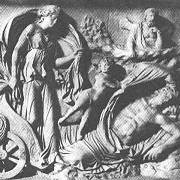 So can a virgin goddess fall in
love? I think it depends on whom you ask. Just as Apollo is sometimes blended
with Helios, the sun god, sometimes Artemis/Diana gets conflated with the moon
goddess Selene. Selene is said to have fallen in love with Endymion, the shepherd
sunk in eternal slumber. In the Selene version, she bore him fifty daughters--presumably
before he fell asleep. When the story transferred over to virginal Artemis, the
daughters disappeared from the mythological record. Perhaps the loveliest version
of that particular story is the one written by John Keats (scroll past Keats's introduction to get to the poem itself), which is told from Endymion's
point of view and begins with one of the most famous lines in the history of English
verse: "A thing of beauty is a joy forever." Endymion's description of his first
sight of the goddess is well worth quoting:
So can a virgin goddess fall in
love? I think it depends on whom you ask. Just as Apollo is sometimes blended
with Helios, the sun god, sometimes Artemis/Diana gets conflated with the moon
goddess Selene. Selene is said to have fallen in love with Endymion, the shepherd
sunk in eternal slumber. In the Selene version, she bore him fifty daughters--presumably
before he fell asleep. When the story transferred over to virginal Artemis, the
daughters disappeared from the mythological record. Perhaps the loveliest version
of that particular story is the one written by John Keats (scroll past Keats's introduction to get to the poem itself), which is told from Endymion's
point of view and begins with one of the most famous lines in the history of English
verse: "A thing of beauty is a joy forever." Endymion's description of his first
sight of the goddess is well worth quoting:
There's also the case of Orion, another constellation who represents a hunter. Artemis shot him with an arrow--there's no question about that--but why? According to some sources it's because he tried to rape her and she retaliated by shooting him, but according to others she fell in love with him and her jealous brother Apollo tricked her into a shooting contest where, unbeknownst to Artemis, Orion was the target. At least he didn't fare quite as badly as Callisto. He even got to take his two favorite hunting dogs with him: they're now known as Canis ("canine") Major and Canis Minor. They are particularly visible during the hot "dog days" of summer... now you know where that phrase comes from!
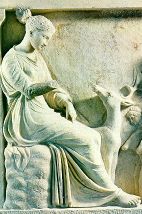 In her role
as the head of the tree cult and patron of springs and lakes, Artemis is usually
depicted as travelling the forests of Arcadia accompanied by a train of nymphs
and dryads (water and tree demigoddesses), whose chastity she protects fiercely.
Woe betide the follower who falls in love or, worse, shows up pregnant: Artemis
considers this a sign of disloyalty.
In her role
as the head of the tree cult and patron of springs and lakes, Artemis is usually
depicted as travelling the forests of Arcadia accompanied by a train of nymphs
and dryads (water and tree demigoddesses), whose chastity she protects fiercely.
Woe betide the follower who falls in love or, worse, shows up pregnant: Artemis
considers this a sign of disloyalty.
Other than that it's a nice life, wandering around with a pack of dogs, shooting at things with your bow, bathing in the occasional pool, and having the power of the goddess to back you up if some roving satyr tries to get too fresh. On the other hand, if you're a mortal, it's best not to get too involved in the Artemis regimen, since the Greeks considered it unnatural for ordinary human beings not to marry and reproduce. Witness the horrible death of Theseus's son Hippolytus, whose excessive zeal for worshipping Artemis led him to neglect Aphrodite with disastrous results.
I'm going to reproduce here the entire "Homeric Hymn to Artemis," because it's really short and it's really beautiful. This is the version posted on The Perseus Project:
I sing of Artemis, whose shafts are of gold, who cheers on the hounds, the pure maiden, shooter of stags, who delights in archery, own sister to Apollo with the golden sword. Over the shadowy hills and windy peaks she draws her golden bow, rejoicing in the chase, and sends out grievous shafts. The tops of the high mountains tremble and the tangled wood echoes awesomely with the outcry of beasts: earth quakes and the sea also where fishes shoal. But the goddess with a bold heart turns every way destroying the race of wild beasts: and when she is satisfied and has cheered her heart, this huntress who delights in arrows slackens her supple bow and goes to the great house of her dear brother Phoebus Apollo, to the rich land of Delphi, there to order the lovely dance of the Muses and Graces. There she hangs up her curved bow and her arrows, and heads and leads the dances, gracefully arrayed, while all they utter their heavenly voice, singing how neat-ankled Leto bare children supreme among the immortals both in thought and in deed.To read more about Artemis, click here and here for entries from the Encyclopedia Mythica and Perseus, click here for Carlos Parada's overview of myths about Artemis in capsule form, and here for ancient texts referring to her. There's also a nice page on Artemis cults at Theoi.com.Hail to you, children of Zeus and rich-haired Leto! And now I will remember you and another song also.
If you liked the Hephaestus pages we looked at in Week Two, you might want to look at this interesting study by the same author
that compares the goddess Diana with Princess Diana, if you didn't already do
so when I linked to it on the discussion board. It actually doesn't have much
about Princess Diana on it, but is mostly interpretation of the classical myth
along with a gallery of nice pictures.
Interested in information on a group of space enthusiasts who want to establish a self-supporting colony on the moon? Suuuuure you are! Check out The Artemis Project.
Return to the top of this page